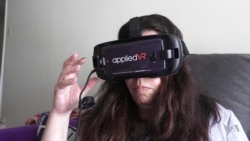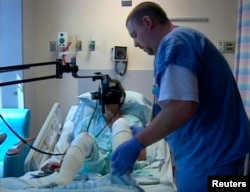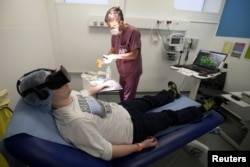Amanda Greene lives with pain.
Greene says her pain comes from lupus, an autoimmune disease that attacks her organs and tissues.
"If I don't have nerve pain, I might have joint pain. If I'm not having joint pain, I might have headaches."
She tried taking medicine and other treatments, but she suffered an allergic reaction to opioids, a strong pain killer.
Now Amanda Greene is trying something different. It is called “virtual reality” therapy.
Virtual reality, or VR, is growing in popularity in video gaming and some training programs. The person wears special equipment that covers the eyes. Inside, he or she sees images and hears sounds coming from a computer program. The experience makes people feel as if they are in the picture they are watching.
For Greene, virtual experience helped her feel more at ease and trained her to breathe in a special way. She saw a tree, crystals, and her breath as she was guided to breathe in and out.
"It worked. It works for me."
VR in hospitals and medical centers
Brennan Spiegel is a doctor who treats patients with stomach pain and intestinal problems. He says these disorders are sometimes connected to a person’s mental health. VR can help, he explains, by changing the messages in the brain and nervous system.
Spiegel is the director of Health Services Research at Cedars-Sinai Hospital in Los Angeles, California. He heads Cedars-Sinai’s virtual reality program, where more than 2,500 patients have been treated.
"Virtual reality can reduce pain, can reduce blood pressure, and now we're looking to see can it do really important things, like reduce the need for opioids."
Opioid abuse has led to many deaths across the United States.
But, unlike opioids, Spiegel does not think patients seeking pain relief would become physically dependent on VR therapy. Researchers are looking at possible side effects. For some patients, less than 10 percent, they may feel off-balance and sick to their stomach when wearing the VR headset.
Spiegel said more than 100 hospitals nationwide are using VR to help patients control pain and nervousness. He added that more countries are taking an interest in VR, and doctors are beginning to develop policies on how to use the technology in health care.
Swamy Venuturupalli is a doctor and the founder of Attune Health, a center treating patients with autoimmune diseases. He is studying how visual technology can reduce the pain his patients feel. VR experiences may include swimming with dolphins and meditation exercises in front of a campfire.
Venuturupalli says VR does more than just distract patients who are in pain. It can train them to learn deep breathing exercises. And it can help them with biofeedback, the ability to control things like heartbeat and brain waves with your mind.
VR pharmacy and centers
A business called AppliedVR is testing virtual reality to see how it may help people deal with their pain. Its president, Josh Sackman, says his company is developing programs that will be helpful to patients of different ages, personalities and interests. He says the goal is to create a VR pharmacy to serve them all.
Sackman told VOA he has seen an improvement in the medical world’s understanding of VR over the past three years. And, he says, with patients using VR, you see a physical change in a short time as they go from someone “in terrible pain, stressed,” to relaxed.
Brennan Spiegel says the aim is not to have the patients stay in their virtual world forever. The idea, he says, is for people to learn in VR that they can control their body, and that the mind matters. And then, people can use those skills when they need it, in the real world.
I’m Anne Ball.
Elizabeth Lee reported on this story for VOANews.com. Anne Ball adapted her report for Learning English. George Grow was the editor.
We want to hear from you. Write to us in the Comments Section.
___________________________________________________________
Words in This Story
autoimmune -adj. of, relating to, or caused by autoantibodies or T cells that attack molecules, cells, or tissues of the organism producing them
allergic -adj. of or relating to a medical condition that causes someone to become sick after eating, touching, or breathing something that is harmless to most people
therapy -n. the treatment of physical or mental illnesses
crystal -n. a clear hard mineral that is either colorless or very light in color and that is used in making jewelry
meditation -n. the act or process of spending time in quiet thought : the act or process of meditating
distract -v. to cause (someone) to stop thinking about or paying attention to someone or something and to think about or pay attention to someone or something else instead
pharmacy -n. a store or part of a store in which drugs and medicines are prepared and sold
relax -v. to stop feeling nervous or worried










